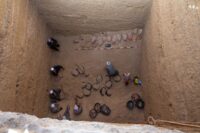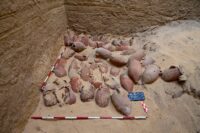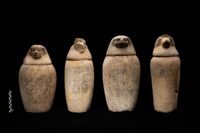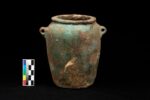 A team of Egyptologists from Charles University in Prague excavating the ancient necropolis at Abusir, 15 miles south of Cairo, have discovered the largest cachette of ancient Egyptian embalming materials ever found. The cachette is intact and undisturbed and contains more than 370 ceramic vessels carefully placed 14 layers deep, and includes some smaller funerary vessels and other materials used in mummification rituals. It dates to the 6th century B.C.
A team of Egyptologists from Charles University in Prague excavating the ancient necropolis at Abusir, 15 miles south of Cairo, have discovered the largest cachette of ancient Egyptian embalming materials ever found. The cachette is intact and undisturbed and contains more than 370 ceramic vessels carefully placed 14 layers deep, and includes some smaller funerary vessels and other materials used in mummification rituals. It dates to the 6th century B.C.
Formal burial of mummification materials was a popular practice in the Late Period. It was something a throwback, a revival of a ritual originally seen in the Old Kingdom. None of the Old or New Kingdom finds, including the cachette found in the intact tomb of Tutankhamun, are anything like this large in scale.
 The discovery was made during routine excavations that have been ongoing for three decades on the western edge of the necropolis near Old Kingdom pyramids. Shaft tombs of important officials — military commanders, priests, courtiers — of the 26th and 27th Dynasties were found here previously. These tombs were only in operation for about 50 years between the two dynasties.
The discovery was made during routine excavations that have been ongoing for three decades on the western edge of the necropolis near Old Kingdom pyramids. Shaft tombs of important officials — military commanders, priests, courtiers — of the 26th and 27th Dynasties were found here previously. These tombs were only in operation for about 50 years between the two dynasties.
The recently-discovered 6th century B.C. shaft tombs are smaller than their more ancient inspirations. The cachette was found inside a shaft 45 feet deep and 16 x 16 feet square. The large amphorae were laid in spiral pattern, winding around the walls in layers varying from seven to 52 deposited vessels.
“The 2021 season was part of a long-term project aiming at excavating and interpreting monuments dating to a period when ancient Egyptian society was looking for new means to maintain its unique identity, then challenged by Greek, Persian and Nubian armies,” said director of the mission Miroslav Bárta.
“The shaft tombs of Abusir, built in a similar fashion to the famous burial of the Pharaoh Djoser, the founder of the Old Kingdom, played a major role in the unique way of cultural expression used by the Egyptian elites of the period,” he added.
 Four limestone canopic jars were found in the top layer of amphorae. They are empty, but the hieroglyphic inscriptions identify the jars as belonging to one Wahibre-Mery-Neith, son of the Lady Irturu.
Four limestone canopic jars were found in the top layer of amphorae. They are empty, but the hieroglyphic inscriptions identify the jars as belonging to one Wahibre-Mery-Neith, son of the Lady Irturu.
“Although a number of dignitaries of this name [Wahibre-Mery-Neith] are known from this period, none of them can be identified as the owner of the canopic jars, as different mothers are attested for all of them. Judging from the size of the embalming deposit and from the dimensions and arrangement of the nearby tomb, the owner of the tomb and of the deposit must have belonged to the highest dignitaries of his time, together with his closest neighbours in the cemetery — the admiral Udjahorresnet and general Menekhibnekau,” said Ladislav Bareš, a leading expert on the period.
 There is a larger shaft next to the mummification materials shaft that the team believes may be the tomb of the Wahibre-Mery-Neith mentioned on the canopic jars. It will be excavated later this year. The cachette is so extensive that the process of removing and analyzing the contents of the cachette is expected to take years.
There is a larger shaft next to the mummification materials shaft that the team believes may be the tomb of the Wahibre-Mery-Neith mentioned on the canopic jars. It will be excavated later this year. The cachette is so extensive that the process of removing and analyzing the contents of the cachette is expected to take years.